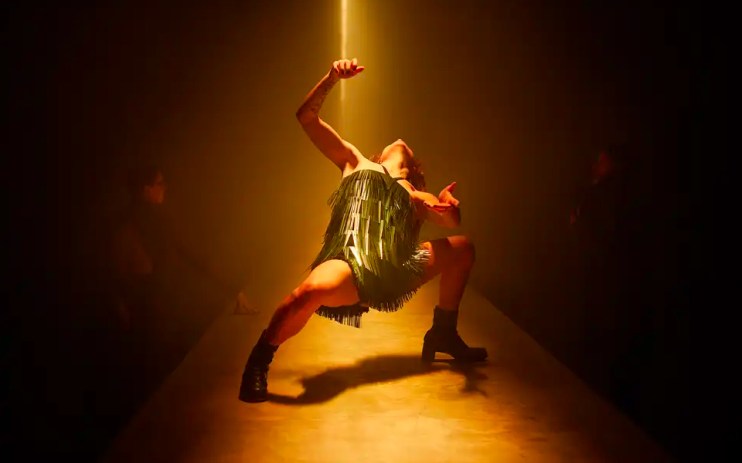The Burnt City review: Punchdrunk return in spectacular fashion

Punchdrunk is the company that put immersive theatre on the map. Its productions of The Drowned Man (2013) and Sleep No More (2003, although best known for its 2011 revival in New York) created the modern blueprint for the medium, spawning a thousand imitators, most of whom only served to highlight how difficult immersive theatre can be to get right.
The company’s singular style blends painstakingly crafted sets – aircraft-hanger sized buildings dressed with an absurd number of props and hand-crafted details – with dozens of performers who roam the space, wordlessly acting out scenes, often through contemporary dance. Crucially, the audience all wear venetian masks, serving the dual purpose of separating them from the cast and emboldening them through anonymity.
After an eight year hiatus, Punchdrunk returns with The Burnt City, a retelling of the sacking of Troy blended with elements of science fiction. Housed in two vast warehouses in Woolwich, downtown Troy becomes a neon playground filled with sake bars, amusement parks and nightclubs, while its rival Greece is a strange, modernist dystopia.
Punchdrunk’s storytelling has always been opaque and that’s certainly the case here. The Burnt City’s story is told through a thousand fragments, and there’s no guarantee which ones you’ll see. It begins with a tour through an exhibition of artefacts recovered by real-life archeologist Heinrich Schliemann, who discovered the location of Troy (he “discovered” it using dynamite, destroying much of it in the process).
The glass case of the final exhibit is smashed, implying – and here the speculation begins – that some ancient power has been unleashed. You’re then in the 1920s, negotiating a series of winding military camps where people appear to have been conducting experiments based on this discovery, which may or may not have caused the past to bleed into the present.
Greek mythology is convoluted at the best of times, so trying to make sense of The Burnt City’s nonlinear vignettes is largely futile. I recognised some of the more famous mythological scenes – the killing of Agamemnon by Clytemnestra; the blinding of Polymnestor by Hecuba – but for the most part it’s best to just let the experience wash over you.
How you spend your three hours is up to you – you could scour old notebooks trying to solve the mystery of what the hell is going on, or you could follow cast members and attempt to watch as many of the narrative elements as possible. The bigger set pieces – usually murders of some description, this being Greek mythology – are uniformly well acted by a cast drawn largely from the contemporary dance scene. The lack of context, though, can become maddening, with the instinct to try to decode the events at odds with the figurative nature of the show.
The Burnt City is best in its quieter moments, when you stumble upon an abandoned shop selling chintzy Christmas decorations, or a wardrobe that, were you to part the clothes, leads to a secret chamber; or a bedroom filled with hundreds of stuffed owls (this could be a reference to owls being a symbol of wisdom associated with the goddess Athena, or it could be because someone on the production team thought it looked cool).
As ever, the attention to detail is incredible, with an expert on ancient Greece brought in to help get the details right, from the shape of the graffiti to the rituals reenacted by the cast.
Punchdrunk has a tendency to wear its influences on its sleeve, with David Lynch near the top of the list; the murky, droning soundscape is straight from his playbook, as is the way the production finds horror within the mundane; one of the actors even recreates the jerky motions of the famous backwards-dancing dwarf in Twin Peaks.
Essays could be written on the psychological effects of the masks. Every now and then I’d look up from a performance and watch the dozens of ghostly white faces voyeuristically circling the actors, jostling with each other and leaning in uncomfortably close (in Sleep No More there were even accusations of sexual assault). It’s a disconcerting sight, the audience becoming a grotesque part of the act.
The only time you’re allowed to remove the mask is at the cabaret lounge, where you can relax with a beer and watch Orpheus belt out 80s classics alongside his backing band the Three Furies.
Punchdrunk is big business – the run has already been extended to December, and with 600 guests per night paying between £55-75, my back-of-a-napkin maths puts the run’s revenue at almost £10m before anyone has visited the bar. This is an astonishing figure for what is essentially an historical drama told through the medium of interpretive dance.
But it never feels like you’re being milked – even finding the bar can be difficult (there may, however, be a chance to stay overnight later in the run, echoing the hotel linked to the New York Sleep No More). This sets The Burnt City apart from other immersive productions – I’m looking at you, Secret Cinema – where the aim of the game often seems to be selling more gourmet burgers, and you can spend more money to unlock extra content.
I did, however, leave with the nagging feeling that this is more of the same from Punchdrunk. Despite the new setting, there are elements that feel interchangeable with the company’s previous works, from the storytelling devices to some of the sets. I’d love to see a company with this much talent and budget really push into radical new territory. As it is, The Burnt City feels like a late-period work from a company happy to play to its strengths. Still, when the result is this good, it’s hard to complain.
